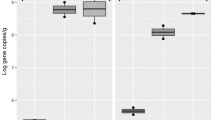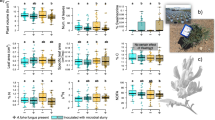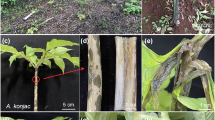Abstract
The leaves of fescue grasses are protected from herbivores by the production of loline alkaloids by the mutualist fungal endophytes Neotyphodium sp. or Epichloë sp. Most bacteria that reside on the leaf surface of such grasses can consume these defensive chemicals. Loline-consuming bacteria are rare on the leaves of other plant species. Several bacterial species including Burkholderia ambifaria recovered from tall fescue could use N-formyl loline as a sole carbon and nitrogen source in culture and achieved population sizes that were about eightfold higher when inoculated onto plants harboring loline-producing fungal endophytes than on plants lacking such endophytes or which were colonized by fungal variants incapable of loline production. In contrast, mutants of B. ambifaria and other bacterial species incapable of loline catabolism achieved similarly low population sizes on tall fescue colonized by loline-producing Neotyphodium sp. and on plants lacking this endophytic fungus. Lolines that are released onto the surface of plants benefiting from a fungal mutualism thus appear to be a major resource that can be exploited by epiphytic bacteria, thereby driving the establishment of a characteristic bacterial community on such plants.
Similar content being viewed by others
Log in or create a free account to read this content
Gain free access to this article, as well as selected content from this journal and more on nature.com
or
References
Bacon CW, White JF . (2003). Evidence for nematode defense in symbiotic grasses. In: White JF Jr, Bacon CW, Hywel-Jones NL, Spatafora JW (eds) Clavicipitalean Fungi: Evolutionary Biology, Chemistry, Biocontrol, and Cultural Impacts. Marcel Dekker: New York, pp 558–559.
Blankenship JD, Spiering MJ, Wilkinson HH, Fannin FF, Bush LP, Schardl CL . (2001). Production of loline alkaloids by the grass endophyte, Neotyphodium uncinatum, in defined media. Phytochemistry 58: 395–401.
Blankenship JD . (2004) Loline alkaloid biosynthesis in Neotyphodium uncinatum, a fungal endophyte of Lolium Pratense. University of Kentucky Doctoral Dissertations, Paper 434.
Bush LP, Cornelius PL, Buckner RC, Varney DR, Chapman RA, Burrus PB et al (1982). Association of N-acetyl loline and N-formyl loline with Epichloe typhina in tall fescue. Crop Sci 22: 941–943.
Coenye T, Vandamme P, Govan JRW, Lipuma JL . (2001). Taxonomy and identification of the Burkholderia cepacia complex. J Clin Microb 39: 3427–3436.
Delmotte N, Knief C, Chaffron S, Innerebner G, Roschitzki B, Schlapbach R et al (2009). Community proteomics reveals insights into the physiology of phyllopshere bacteria. Proc Natl Acad Sci USA 106: 16428–16433.
De-wen T, Wang J-y, Patchett B, Gooneratne R . (2006). Seasonal change of loline alkaloids in endophyte-infected meadow fescue. Ag Sci China 5: 793–797.
Gardener BBM, Bruijn FJD . (1998). Detection and isolation of novel rhizopine-catabolizing bacteria from the environment. Appl Environ Microb 64: 4944–4949.
Galperin MY . (2006). Structural classification of bacterial response regulators: diversity of output domains and domain combinations. J Bacteriol 188: 4169–4182.
Gerstmeir R, Cramer A, Dangel P, Schaffer S, Eikmanns BJ . (2004). RamB, a novel transcriptional regulator of genes involved in acetate metabolism of Corynebacterium glutamicum. J. Bacteriol 186: 2798–2809.
Gordon DM, Ryder MH, Heinrich K, Murphy PJ . (1996). An experimental test of the rhizopine concept in Rhizobium meliloti. Appl Environ Microb 62: 3991–3996.
Hallmann J, Quadt-Hallmann A, Mahaffee WF, Kloepper JW . (1997). Bacterial endophytes in agricultural crops. Can J Microb 43: 895–914.
Hartmann A, Schmid M, van Tuinen D, Berg G . (2009). Plant-driven selection of microbes. Plant Soil 321: 235–257.
Justus M, Witte L, Hartmann T . (1997). Levels and tissue distribution of loline alkaloids in endophyte-infected Festuca pratensis. Phytochemistry 44: 51–57.
Kim K-S . (2000). Opine, a chemical mediator governing physiology of the plant-pathogen, Agrobacterium, in the rhizosphere. Plant Pathol J 16: 55–62.
King EO, Ward MK, Raney DE . (1954). Two simple media for the demonstration of pyocyanin and fluorescin. J Lab Clin Med 44: 301–307.
Kobayashi DY, Palumbo JD . (2000). Bacterial endophytes and their effects on plants and uses in agriculture. In: Bacon CW, White JF Jr (ed.) Microbial Endophytes. Marcel Dekker, Inc.: New York, pp 199–233.
Koulman A, Lane GA, Christensen MJ, Fraser K, Tapper BA . (2007). Peramine and other fungal alkaloids are exuded in the guttation fluid of endophyte-infected grasses. Phytochemistry 68: 355–360.
Lindow SE, Brandl MT . (2003). Microbiology of the phyllosphere. Appl Environ Microb 69: 1875–1883.
Mercier J, Lindow SE . (2000). Role of leaf surface sugars in colonization of plants by bacterial epiphytes. Appl Environ Microb 66: 369–374.
Murphy PJ, Wexler W, Grzemski W, Rao JP, Gordon D . (1995). Rhizopines- their role in symbiosis and competition. Soil Biol Biochem 27: 525–529.
Narasimhan K, Basheer C, Bajic VB, Swarup S . (2003). Enhancement of plant-microbe interactions using a rhizosphere metabolomics-driven approach and its application in the removal of polychlorinated biphenyls. Pl Physiol 132: 146–153.
O'Toole G, Kolter R . (1998). Initiation of biofilm formation in Pseudomonas fluorescens WCS365 proceeds via multiple, converging signaling pathways: a genetic analysis. Mol Microb 28: 449–461.
Porras-Alfaro A, Bayman P . (2011). Hidden fungi, emergent properties: Endophytes and microbiomes. Ann Rev Phytopathology 49: 291–315.
Sambrook JR, Fritsch EF, Maniatis T . (1989) Molecular Cloning: A Laboratory Manual 2nd edn. Cold Spring Harbor Laboratory Press: Cold Spring Harbor, NY.
Sandhu A, Halverson LJ, Beattie GA . (2007). Bacterial degradation of airborne phenol in the phyllosphere. Env Microbiol 9: 383–392.
Schardl CL, Grossman RB, Nagabhyru P, Faulkner J, Mallik UP . (2007). Loline alkaloids: currencies of mutualism. Phytochemistry 68: 980–996.
Schardl C, Moon CD . (2003). Processes of species evolution in Epichloë/Neotyphodium endopytes of grasses. In: White JF Jr, Bacon CW, Hywel-Jones NL, Spatafora JW (ed) Clavicipitalean Fungi: Evolutionary Biology, Chemistry, Biocontrol and Cultural Impacts. Marcel Dekker: New York, pp 255–289.
Suda W, Nagasaki A, Shishido M . (2009). Powdery mildew-infection changes bacterial community composition in the phyllosphere. Microbes Environ 24: 217–223.
Sy S, Timmers ACJ, Knief C, Vorholt JA . (2005). Methylotrophic metabolism is advantageous for Methylobacterium extorquens during colonization of Medicago truncatula under com. Appl Environ Microbiol 71: 7245–7252.
Takeda A, Suzuki E, Kamei K, Nakata H . (1991). Detection and indentification of loline and its analogs in horse urine. Chem Pharmaceut Bull 39: 964–968.
Tukey HJ . (1970). The leaching of substances from plants. Ann Rev Plant Physiol 21: 305–324.
Vorholt JA . (2012). Microbial life in the phyllopshere. Nat Rev Microb 10: 828–840.
White JF . (1987). Widespread distribution of endophytes in the Poaceae. Plant Disease 71: 340–342.
Wilkinson H, Siegel MR, Blankenship JD, Mallory AC, Bush LP, Schardl CL . (2000). Contribution of fungal loline alkaloids to protection from aphids in a grass-endophyte mutualism. Molec Plant-Microbe Interact 13: 1027–1033.
Wilson M, Lindow SE . (1994). Coexistence among epiphytic bacterial populations mediated through nutritional resource partitioning. Appl Environ Microb 60: 4468–4477.
Wilson M, Lindow SE . (1993). Interactions between the biological control agent Pseudomonas fluorescens A506 and Erwinia amylovora in pear blossoms. Phytopathology 83: 117–123.
Wilson M, Savka MA, Hwang I, Farrand SK, Lindow SE . (1995). Altered epiphytic colonization of mannityl opine-producing transgenic tobacco plants by a mannityl opine-catabolizing strain of Pseudomonas syringae. Appl Environ Microb 61: 2151–2158.
Yates SG, Petroski RJ, Powell RG . (1990). Analysis of loline alkaloids in endophyte-infected tall fescue by capillary gas chromatography. J Ag Food Chem 38: 182–185.
Acknowledgements
This work was funded in part by National Science Foundation Postdoctoral Fellowship 0610319 to ER. We are grateful to Dr Ellen Beaulieu for her help with mass spectrometry and other chemical analyses. We also thank Lena Tran for her assistance in generating transposon mutants and in other aspects of the study and Sara Sirvanchai for helpful comments on the manuscript. We are also grateful to Chris Schardl for supplying seeds of Meadow Fescue infected with loline-deficient strains of Epichloë.
Author information
Authors and Affiliations
Corresponding author
Ethics declarations
Competing interests
The authors declare no conflict of interest.
Additional information
Supplementary Information accompanies this paper on The ISME Journal website
Supplementary information
Rights and permissions
About this article
Cite this article
Roberts, E., Lindow, S. Loline alkaloid production by fungal endophytes of Fescue species select for particular epiphytic bacterial microflora. ISME J 8, 359–368 (2014). https://doi.org/10.1038/ismej.2013.170
Received:
Revised:
Accepted:
Published:
Issue date:
DOI: https://doi.org/10.1038/ismej.2013.170



